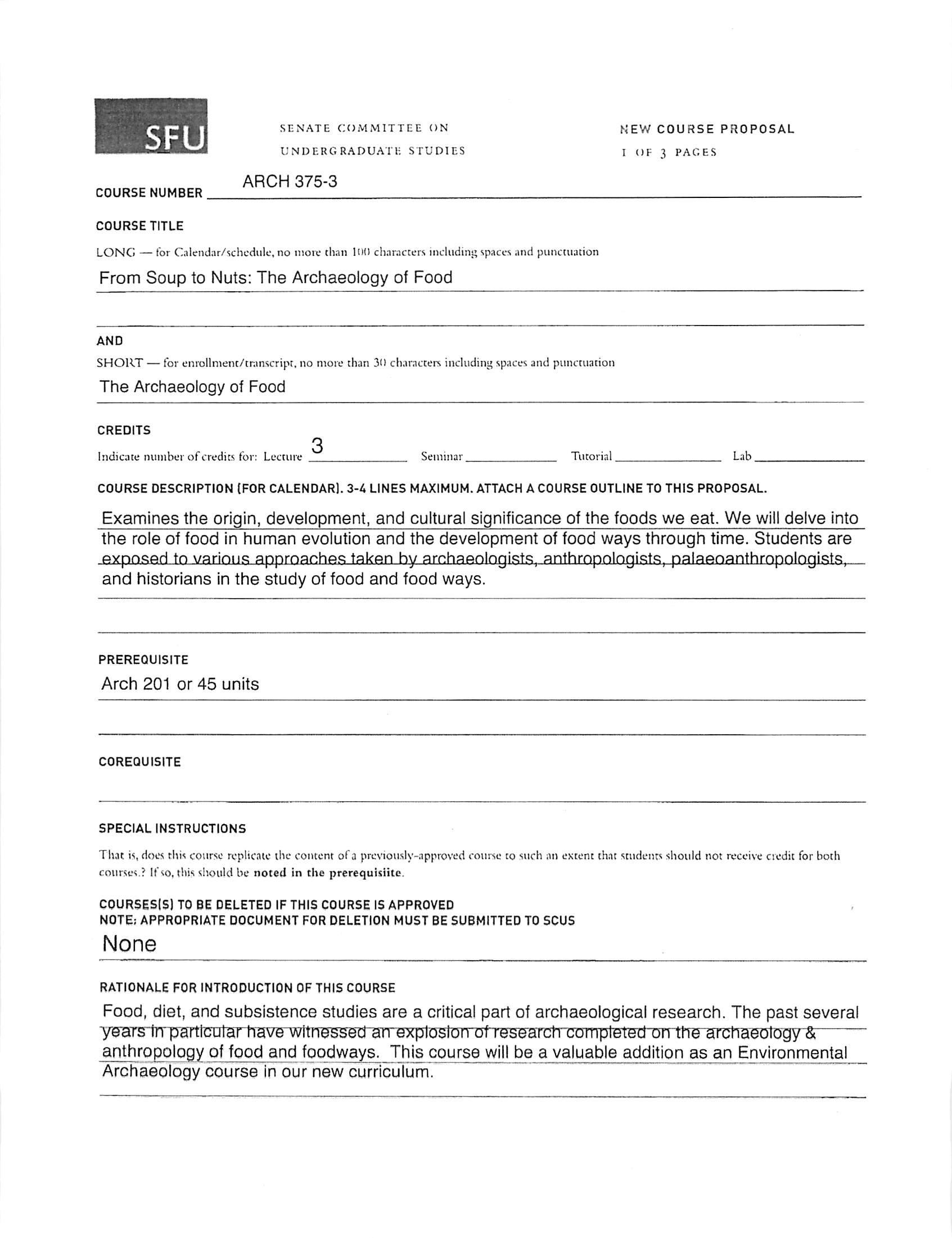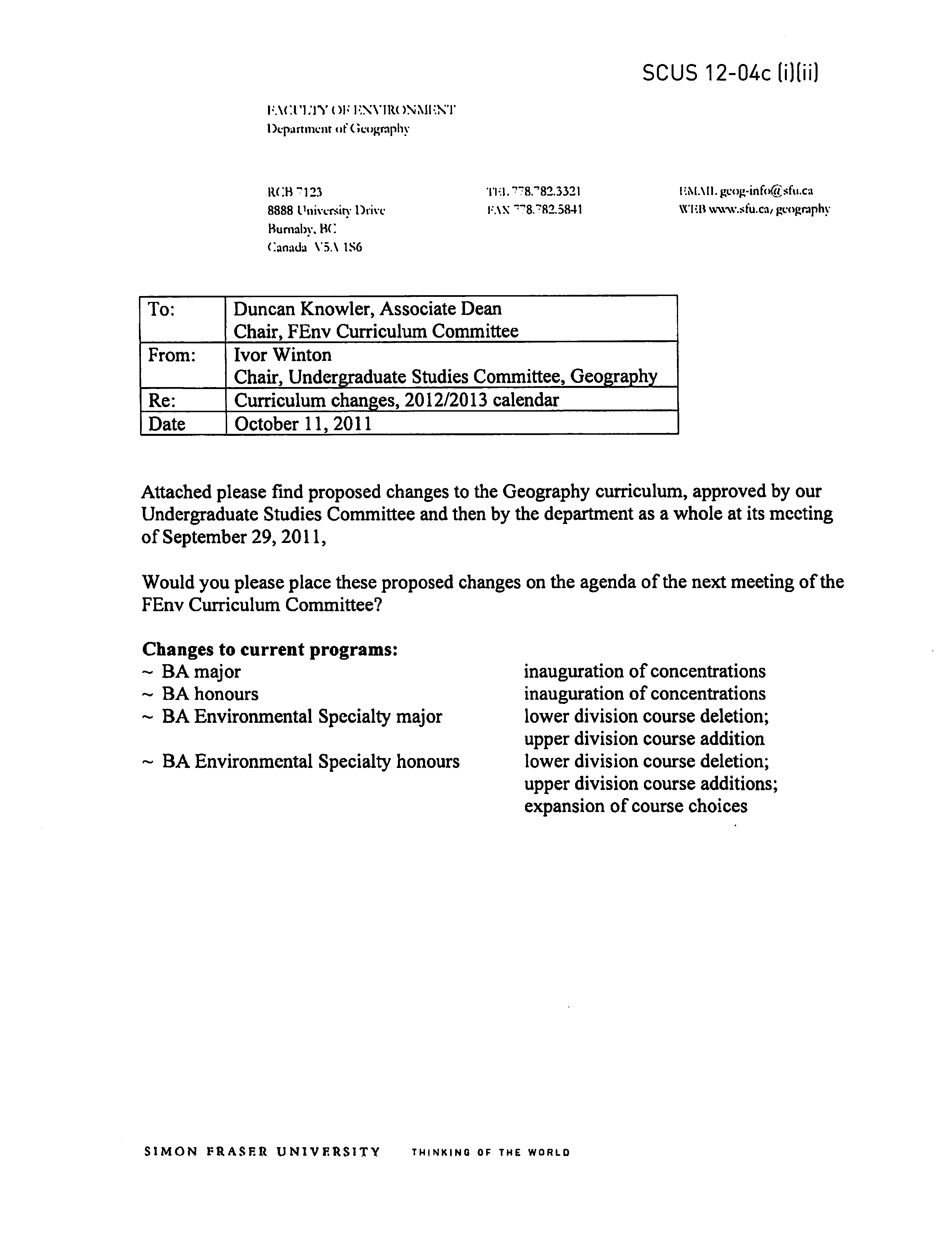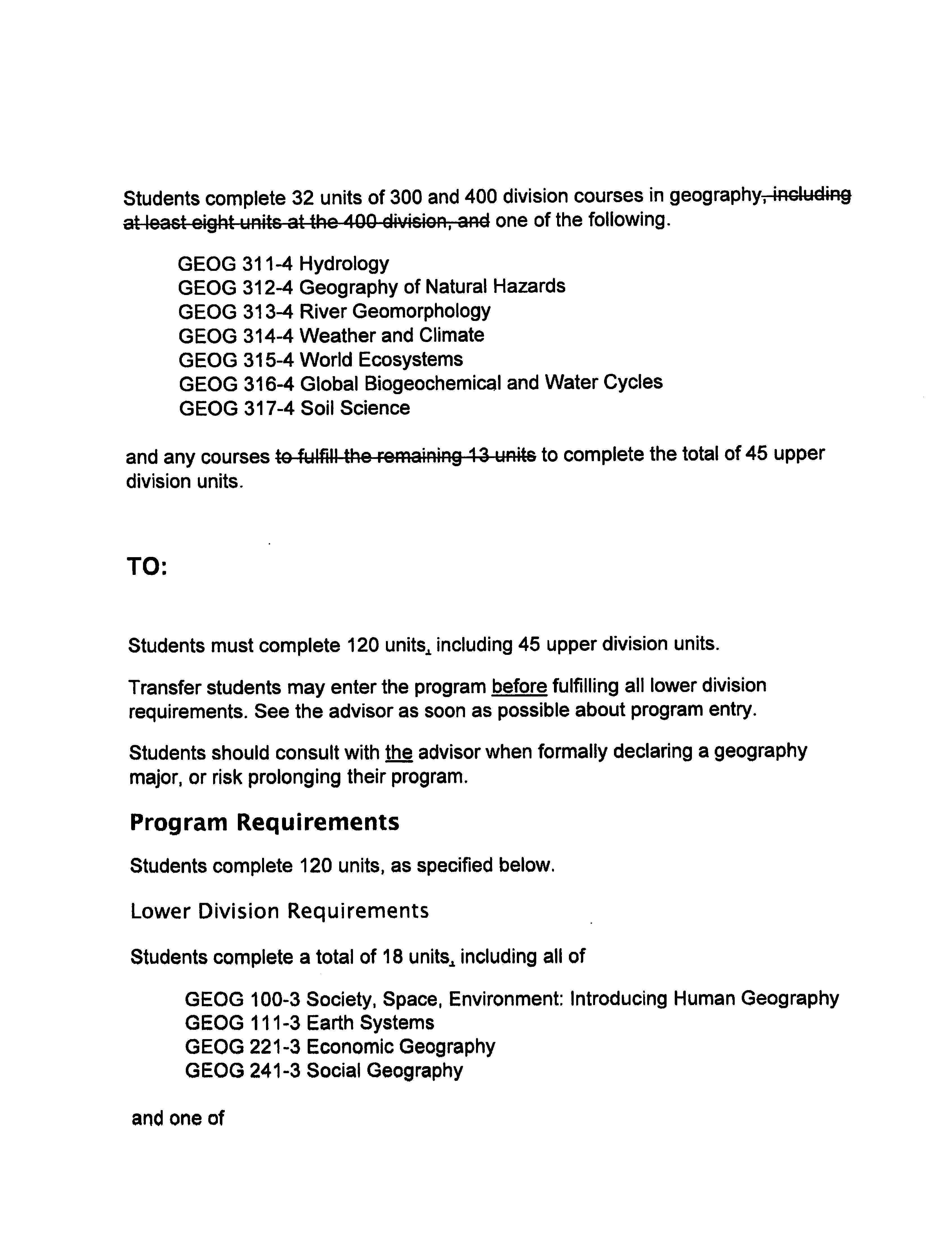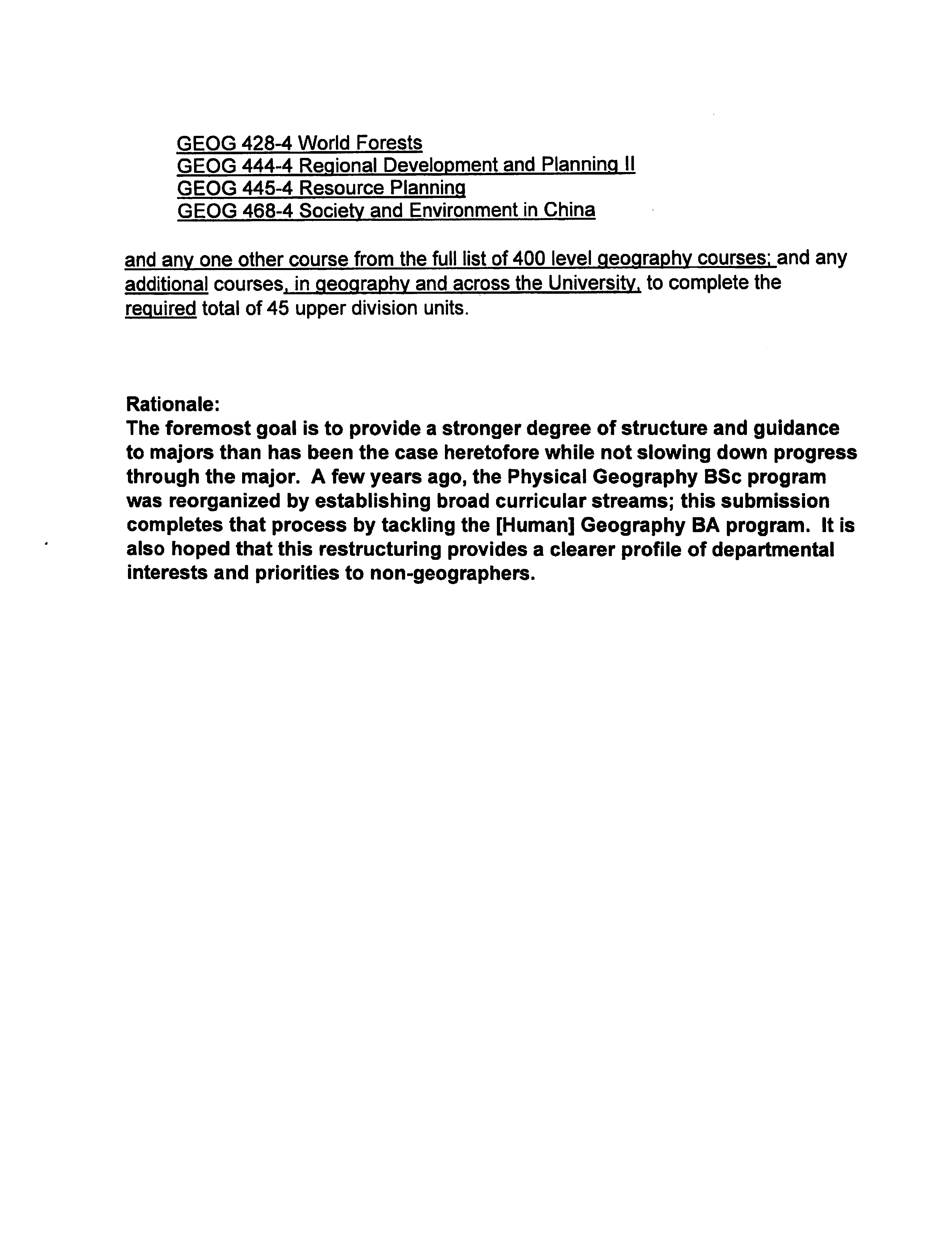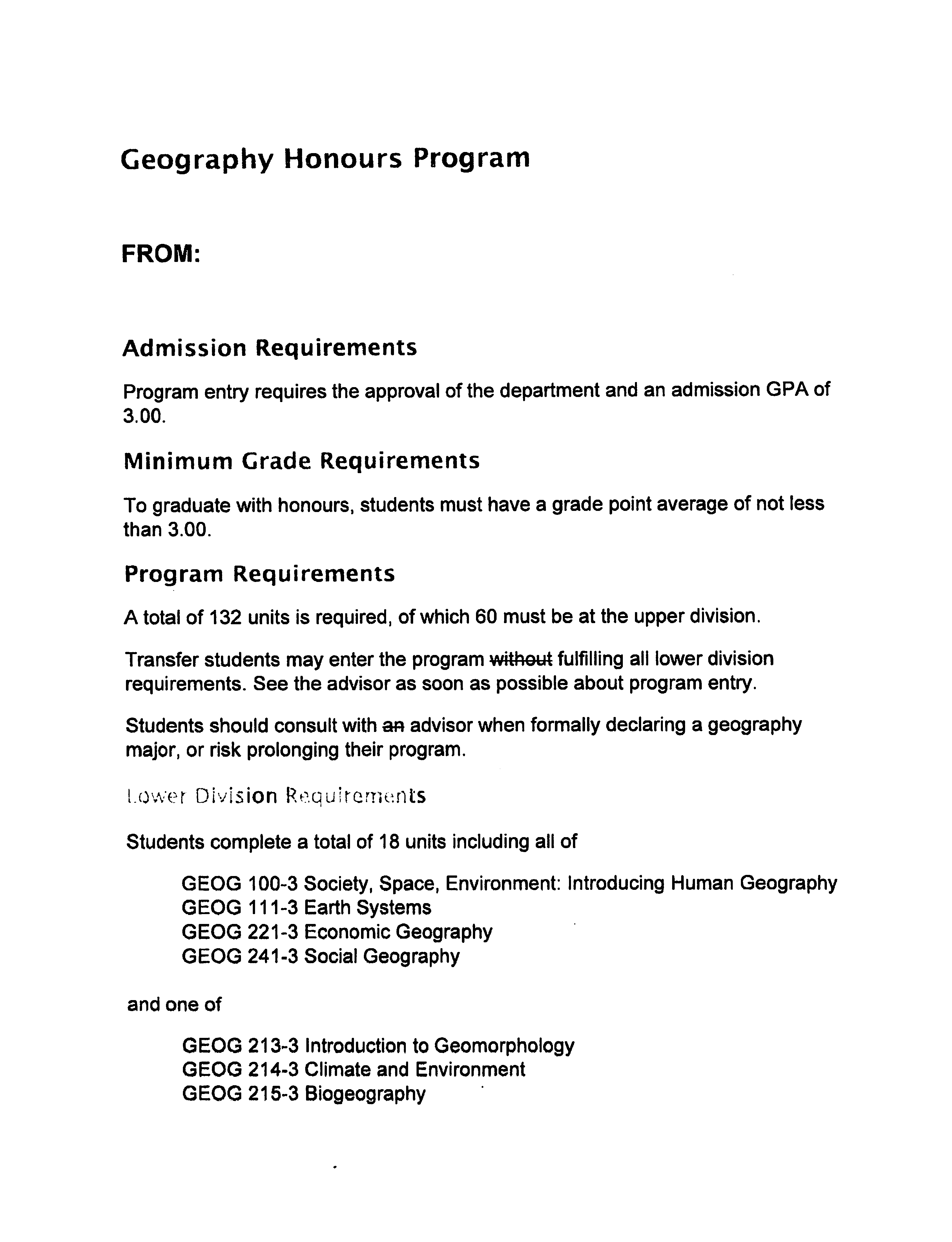SFU
S.12-49
OFFICE OF THE ASSOCIATE VICE-PRESIDENT, ACADEMIC AND
ASSOCIATE PROVOST
8888 University Drive, TEL: 778.782.4636
avpcioiasfu.ca
Burnaby, BC
www.sfu.ca/vpacademic
Canada V5A1S6
MEMORANDUM
ATTENTION
Senate
DATE
February 3, 2012
FROM
Bill Krane, Chair
PAGES
Senate Committee on
Undergraduate Studies
1/1
RE:
Faculty of Environment (SCUS 12-04)
//ki&^-^-^
For information:
Acting under delegated authority at its meeting of February 2, 2012, SCUS approved the
following curriculum revisions effective Fall 2012:
1. Department of Archaeology (SCUS 12-04a)
II] Reinstate ARCH 450 and 451
(ii) New Course Proposal: ARCH 375-3, From Soup to Nuts: The Archaeology of Food.
2. New Course Proposal for ENV320W-3, Ethics and the Environment (SCUS 12-04b)
3. Department of Geography (SCUS 12-04c]
(i)
Lower Division and Upper Division Requirement changes to the Geography
Major and Honors Programs to include new Concentrations:
a. Society & Environment
b. Resources, Economy, & Environment
(ii) Lower and Upper Division Requirement changes to the Geography Environmental
Specialty Major and Honors Programs
4. Temporarily Withdrawn Courses (SCUS 12-04d)
(i) Temporarily withdraw GEOG 412 and 417 (non Wcourses)
Senators wishing to consult a more detailed report of curriculum revisions may do so by going
to Docushare: https://docushare.sfu.ca/dsweb/View/Collection-12682
If you are unable to access the information, please call 778-782-3168 or email
shelley qairOsfu.ca.
SIMON FRASER UNIVERSITY
thinking of the world
SFU
FACULTY OI; ENVIRONMENT
TASC 2 Building, Room 8900
8888 University Drive, Burnaby, BC
Canada V5A IS6
Jo Hinchliffe
Assistant Registrar
Student Services
December 14,2011
TKL 778.782.8787
PAX 778.782.8788
www.fenv.sfu.ca/
SCUS 12-04-a (i)
Greetings Jo,
re removed-from tho calendar in error. _j^
In October 2010 following two courses wer
ARCH 450
Practicum III
ARCH 451
Practicum IV
The Archaeology Department and the Faculty of Environment would like these courses
reactivated so that they may appear in the calendar and be scheduled from summer 2012.
T Hani* you
Hincan Knowler
FENV Associate Dean
Dan Burns
FENV Manager Academic and Curriculum Planning
Chris Papaianni
Archaeology
Manager Academic and Administrative Services
SIMON FRASER UNIVERSITY
thinking of the world
MEMO
Dean's Office
TASC 2. Suite 8900
Tel:
778-782-8787
www.fenv.sfu.ca
SFU
FACULTY OF ENVIRONMENT
SCUS 12-04a (ii
ATTENTION
Bill Krane, Chair, SCUS
|
FROM
Duncan Knov/ler, Chair, FENV Curriculum Committee
RE
Faculty of
Environment Course and Program Changes
J_
|
DATE
December 21, 2011
A. The following were approved by the Faculty of Environment Undergraduate
Curriculum Committee at its meeting of December 1, 2011 and are being
forwarded to SCUS for approval and recommendation to Senate.
i.
Department of Archaeology (ARCH)
ARCH 375-3 - new course proposal
ii.
Faculty of Environment (ENV)
ENV 320-3 - new course proposal
iii.
Department of Geography (GEOG)
changes to BA major, BA honours, BA Environmental Specialty major
and BA Environmental Specialty honours to indicate "concentrations"
PLEASE NOTE: For the Geography changes we wish to include approval for
indicating the "concentration" on students' transcripts. Could you please
consider this together with the above noted changes.
B. Temporary withdrawal of GEOG 412 & 417 (see attached memo)
Please add these items to the agenda for the next SCUS meeting.
Thanks kindly,
Duncan Knowler
Associate Dean, FENV
mmo.n phase;; uxiviutxiTY thinking of the wcrlo
SFU
COURSE NUMBER
SENATE COMMITTEE ON
NEW COURSE PROPOSAL
UNDERGRADUATE STUDIES
I of 3 PAGES
ARCH 375-3
COURSE TITLE
LONG — tbr Calendar/schedule, no more than 100 characters including spacesand punctuation
From Soup to Nuts: The Archaeology of Food
AND
SHORT — for enrollment/transcript, no more than 30 characters including spaces and punctuation
The Archaeology of Food
CREDITS
3
Indicate number of credits for: Lecture
, Seminar
Tutorial
Lab.
COURSE DESCRIPTION [FOR CALENDAR). 3-4 LINES MAXIMUM. ATTACH A COURSE OUTLINE TO THIS PROPOSAL.
Examines the origin, development, and cultural significance of the foods we eat. We will delve into
the role of food in human evolution and the development of food ways through time. Students are
exposed to various approaches taken hy archaeologists, anthropologists, palaeoanthropologists,
and historians in the study of food and food ways.
PREREQUISITE
Arch 201 or 45 units
COREQUISITE
SPECIAL INSTRUCTIONS
That is, does this course replicate the content of a previously-approvedcourse to such an extent that students should not receive ciedit for both
courses.? Ifso.this should be noted in the prerequisiito.
COURSES(S) TO BE DELETED IF THIS COURSE IS APPROVED
NOTE; APPROPRIATE DOCUMENT FOR DELETION MUST BE SUBMITTED TO SCUS
None
RATIONALE FOR INTRODUCTION OF THIS COURSE
Food, diet, and subsistence studies are a critical part of archaeological research. The past several
ye~aTs~trrpHrtiuutHrh^v^^
archaeology^;
anthropology of food and foodways. This course will be a valuable addition as an Environmental
Archaeology course in our new curriculum.
SFU
SENATE COMMITTEE ON
NEW COURSE PROPOSAL
UNDERGRADUATE STUDIES
2 OF 3 PAGES
SCHEDULING AND ENROLLMENT INFORMATION
Indicate effective term and year course would first be offered and planned frequency of offering thereafter:
Fall 2012
(NOTE:There is a two-term wait for implementation of any new course.)
Indicate if there is a waiver required: DyES H NO Will this be a required or elective course in the curriculum? U Required H Elective
.60
What is the probable enrollment when orleredr Estimate
Which of your present CFL faculty have the expertise to otVer this course?
Cathy D'Andrea, Dana Lepofsky
Are there any proposed student fees associated with this course other than tuition fees?
I—lYES
IMJ NO
(If yes, attach mandatory supplementary fee approval form.)
RESOURCE IMPLICATIONS
NOTE: Senate has approved (S.93-11) that no new course should be approved by Senate until funding has been committed for necessary library
materials. Each new course proposal must be accompanied by a library report and, if appropriate, confirmation that funding arrangements have been
addressed.
. Bumaby
lere course will oe taught
±_
Campus whe
Initiated
Library report status.
Provide details on how existing instructional resources will be redistributed to accommodate this new course. For example, will another course
be eliminated or will the frequency of offering of other courses be reduced; are there changes in pedagogical style or class sizes that allow for this
additional course offering?
Adding this course will not significantly impact our other offerings. It may mean that D'Andrea will
teach only I sB'ctlOTrof^TcrrlTXTaTher than 2. Other faculty or sesslOTTatlrTsiriTctoTs can teach
Arch 100.
List any outstanding resource issues to be addressed prior to implementation: space, laboratory equipment, etc:
None
Articulation agreement reviewed?
I lYES
I—I NO
HJ Not applicable
OTHER IMPLICATIONS
SFU
APPROVALS
Si NATE ON VllTTEE ON
I'NDr.RCRA./l'AT, STUDIES
NEW COURSE PROPOSAL
3 01 3 PACTS
1
Departmental approval indicates that the Department or School his approved the content of the course, and has consulted with
other D,^p^rtmcnra/ScI|ool,s/raculties regarding proposed coursi content and overlap issues.
J, :'l>177. <\l
•,
2k
££U_
Chair, Department/School
Chair, Faculty Curriculum Committee
2
Faculty oyprova
Faculty/
Dean or designate
Ik k)o\, Ion
Date
Date
ary course content and overlap concerns have been resolved, ."id that the
omrnits to/p/oviding the required Library funds.
21 hts.JQU
Date
LIST v'.i.vh other Departments. •_!•,, :, ,iu Flu»Mc> have bn ice r. ii Jr.. uding the pi.:;ic cd irune ci ent.in aiding •/•.rl p; -ue: \tr .ch
documentary cvldn c #frt«f< ises.
Other Fucilties approval i. >.i .- I that the D. n(.) or Design i. •"<.•• •r Hacu.tii, AFTLCTl" "^ Iy :li< proposed ne.v cour ••• v p >rl
'$
d
-
ll ?•*"•" ot
the new (.our e:
_ _
D-ue
i^atc
3
SCUS approval indi -dies th.it the course has been approved for implementation subject, \nhere appropriate, <o financial issues
being addressed.
COURSE APPROVED BY SCUS (Chair of SCUS):
_^ _
. Dvc
-
APPROVAL IS SIGNIFIED BY DATEAND APPROPRIATE SIGNATURE.
ARCHAEOLOGY 397
From Soup to Nuts: The Archaeology of Food
Instructor:
Dr. Catherine D'Andrea
Office:
EDU 9635
Office:
EDU 9644
Tel:
778 782-5790
Tel:
778 782-4178
E-mail:
adandrea@sfu.ca
E-mail:
TBA
Office Hours:
TBA
Office Hours:
TBA
Prerequisites:
Arch 201 or 45 credit hours.
Required Readings:
Will be assigned each week.
This course may be used as an upperdivision course requirement for Group
//,
Environmental Archaeology Courses.
Course Description and Objectives:
Food is a universal human requirement, and over time cultures from around the world have
developed radically different cuisines. Or have they? In this course we will examine the origin,
development, and cultural significance of the foods we eat. We will delve into the role of food
in human evolution and the development of food ways through time. We will discover the
earliest known foods, and foods of foraging societies, first farmers, early states, the global
scale food exchange with the "discovery" of the New World, and the future of food. Students
are exposed to various approaches taken by archaeologists, anthropologists,
palaeoanthropologists, and historians in the study of food and food ways.
Grade Distribution:
Lecture Exam
30%
Research Paper
30%
Group Seminar Presentation
30%
Seminar Participation
10%
Research paper:
Each student will write a paper involving a critical investigation of the origin, development
(including domestication history, where applicable), and cultural significance of a modern food
(topic to be approved by the Instructor), e.g., maize, coffee, goat, salmon, carrots, beer,
chocolate, beef, sweet potato, banana, coconuts, kumquats,
etc.
Choose your favourite
food-creativity is strongly encouraged!
Group project and seminar presentation:
Class will be divided into groups of 5 and each team will examine the origin, history and
cultural significance of a regional cuisine (to be approved by the Instructor),
e.g.,
India, Middle
East, Africa, Europe, Mexico, China,
etc.
SFU
COURSE NUMBER
COURSE TITLE
SCUS 12-04b (Revised)
SENATE COMMITTEE ON
NEW COURSE PROPOSAL
UNDERGRADUATE STUDIES
i or 3 PAGES
ENV 320-3 W
LONG — for Calendar, schedule, no more than Kill charactersincluding spaces and punctuation
Ethics and the Environment
AND
SHORT — for enrollment 'transcript, no more than 3D characters including spaces and punctuation
Ethics and the Environment
CREDITS
3
Indicate number of credits for: Lecture
Seminar
Tutorial
Lab
COURSE DESCRIPTION (FOR CALENDAR). 3-4 LINES MAXIMUM. ATTACH A COURSE OUTLINE TO THIS PROPOSAL.
An introduction to the field of environmental ethics for non-specialists. Addresses questions such
as what obligations we have to future generations and the natural world, as well as the extent of
these obligations.
PREREQUISITE
Students must have earned at least 45 units. Students who have taken PHIL 333-3 or ENV 399-3 "Special Topics in
Environmental Ethics" prior to or in 2011 and studeftts-w4th-efedit-in PHIL 32&-3-may-flOt enroll in this course for
credit. Philosophy Majors and Minors may not take this course for credit towards their major or minor degree.
COREQUISITE
N/A
SPECIAL INSTRUCTIONS
That is, does this eoup.e replicare the content of a previously-approved course to such an extent that students should not receive credit for both
courses.? Ifso,this should be noted in the prercquisiitc.
C0URSESI5) TO BE DELETED IF THIS COURSE IS APPROVED
NOTE: APPROPRIATE DOCUMENT FOR DELETION MUST BE SUBMITTED TO SCUS
N/A
RATIONALE FOR INTRODUCTION OF THIS COURSE
This course will be one of three ENV courses (ecological economics, environmentaj_ethics and
environmental law) that will be required in the redesigned EVSC major program." Thus, this course
JsJnj£nd£icLJQj_sludentR who are non-spflrtaiislsJD_PbilLJntent
is. for this to hft a IJD "W" course in
the EVSC program.
SFU
SENATE COMMITTEE ON
NEW COURSE PROPOSAL
UNDERGRADUATE STUDIES
2 OP 3 PACES
SCHEDULING AND ENROLLMENT INFORMATION
Indicate effective term and year course would first be offered and planned frequency of ottering thereafter:
Fall 2012
(NOTE:There is a two-term wait for implementation of any new course.)
Indicate if there is a v liver required: I lYES HJ NO Will this be a required or elective course in the curriculum? H Required I—I Elective
35 to 50
What is the probable enrollment when offered?
Estimate
Which of your present CFL faculty have the expertise to offer this course?
Dai Heide (via buyout from PHIL)
Are there any proposed student fees associated with this course other than tuition fees?
I—lYES
HJ NO
(If yes,attach mandatory supplementary fee approval form.)
RESOURCE IMPLICATIONS
NOTE: Senate has approved (S.93-11) that no new course should be approved by Senate until funding has been committed for necessary library
materials. Each new course proposal must be accompanied by a library report and, if appropriate, confirmation that funding arrangements have been
addressed.
, Burnaby
Campus where course will be taught
.
.—
in progress
Library report status
\
^
Provide details on how existing instructional resources will be redistributed to accommodate this new course. For example, will another course
be eliminated or will the frequency of offering of other courses be reduced; are there changes in pedagogical style or class sizes that allow for this
additional course offering?
FENV does not currently have expertise for the teaching of this course so we anticipate the
required buyout from PHIL will continue for the foreseeable future. Funding will be provided by the
Collaborative Teaching T^llows-Rr-ograro-managed by the-FENV-Dear^s Office.
List any outstanding resource issues to be addressed prior to implementation: space, laboratory equipment,etc:
N/A
Articulation agreement reviev ed?
I lYES
I—I NO
HI Not applicable
OTHER IMPLICATIONS
SFU
S'
U/YYY:
COMMITVH" ()M
UNDF.HG RADUATF STUDIES
MEW cu'.'r^l: propo.sal
s OP s PAGsS
APPROVALS
1
Departmental approval indicates that the Department or School has approved the content of the course, and has consulted with
other Departments/Schools/Faculties regarding proposed course content and overlap issues.
Chair, Dep
Faculty {approval indicates thAtkll the necessary course content and overlap concerns have been resolved, and that the
FacultylS/h^ol/Depactmentjcommits to providing the required Library funds.
kt.JI.MI
Dean or designate
A%nJ J3.J6/I
h
Date
h
Date
+
LIST which other Departments, Schools and Faculties have been consulted regarding the proposed course content, including overlap issues. Attach
documentary evidence of responses.
Other Faculties approval indicated that the Dean(s) or Designate of other Faculties AFFECTED by the proposed new course support(s) the approval of
the new course:
Date-
Date
3
SCUS approval indicates that the course has been approved for implementation subject, where appropriate, to financial issues
being addressed.
COURSE APPROVED BY SCUS (Chair of SCUS):
Date
APPROVAL IS SIGNIFIED BY DATE AND APPROPRIATE SIGNATURE.
ENV 320-3 - Ethics and the Environment
Dr. Dai Heide
Office: WMC 5655
Phone: (778) 782-4806
Course Description:
What obligations do we have to the things we encounter in the
natural world? We may agree that we humans have obligations to one another - but
how extensive are these obligations? And what about other entities? Do we have
obligations to future generations? May we do as we please with animals, or do they
have significant moral standing? Is the natural world intrinsically morally valuable, or is
it simply a means to
our human ends?
We will begin with the difficult philosophical task of determining a standard of moral
significance. In so doing, we will be compelled to consider
a
range of arguments in favor
of abandoning the anthropocentric view that only humans are intrinsically morally
significant. We shall then consider and evaluate a range of views that hold that the
natural world is morally significant. Toward the end of the course, we shall consider
some of the social and political implications of these views. One significant means of
accomplishing these goals shall be close attention to case studies.
Required Text:
Holmes and Rolston (eds.),
Environmental Ethics: An Anthology.
(Blackwell; ISBN: 978-0631222941)
Assignments, Policies and Grades
Assignments and Grades:
Your grade will be determined on the basis of four factors:
1) Three short (one page) response papers (25%)
2) Classroom presentation (15%)
3) Term paper, revised in light of instructor comments on required draft (30%)
4) Final exam (30%)
Topics for response papers will be posted on Monday every week beginning in the third
weekof the term and endingin the 12th week of the term. Response papers are due in
class the week they are posted. You are responsiblefor writing three of them throughout
the term and you may pick which weeks you write them.
Classroom presentations will begin several weeks into the term. They will be done in
groups - and the size of the group will depend upon decisions we make early in the
term. Presentations will have several components. You and your group will research an
environmental case study in which an ethical conflict arises. You will circulate to the
classthe Monday of the week in which you present
a
brief background to the issue and a
brief description of the case study, including a description of the outcome. This is so the
rest of the class will be prepared to engage with you during your presentation. Your
presentation will involve an analysis of the case study in light of various ethical concepts
and theories we have discussed in class.
Term papers will be assigned at a later date and some significant portion of class time
will be devoted to discussing how to write a successful term paper. For those of you
who are new to philosophy, the earlieryou have a look at the following document, the
better: http:/ /www.jimpryor.net/teaching/guidelines/writing.html- Anelectronic copy
of a rough draft is required and you are required to turn in a
complete draft
in order to be
eligible for full credit on the final version of the term paper. I will provide you with
electronic comments on your paper in advance of the due date for the final version.
The final exam will cover topics from the entire course and will be largely a written
exam. Details about the exam will be covered as we go along.
MEMO
ADDRESS
88 8 8 University Drive
burnaby bc v5a 1s6
Canada
SFU
UNIVERSITY CURRICULUM & INSTITUTIONAL LIAISON
OFFICE OF THE VICE PRESIDENT ACADEMIC AND PROVOST
ATTENTION Duncan
Knowler, Jo Hinc
lif f e
| TEL
FROM
SUSAN RHODES , Assistant Director, Univers
Institutional Liaison
ty
c
urriculum and
RE fc
des ignat ion
DATE
February 1, 2012
TIME 4:35 PM
Please be advised that the University Curriculum Office has approved W
designation for the new course
ENV 320 Ethics and the Environment
SIMON FIIASEK UNIVERSITY
THINKING 0 F THE WORLD
I'ACl'l/lYOL"KXYIRONMUNT
Department of Geography
R(:B"123
8888 University Drive
Burnaby. BC
Canada \"5.\ 1S6
THL7~8."'82.3321
FAX -"8."782.5841
SCUS12-04c(i)[ii)
WKB www.sfu.ca/geography
To:
Duncan Knowler, Associate Dean
Chair, FEnv Curriculum Committee
From:
Ivor Winton
Chair, Undergraduate Studies Committee, Geography
Re:
Curriculum changes, 2012/2013 calendar
Date
October 11,2011
Attached please find proposed changes to the Geography curriculum, approved by our
Undergraduate Studies Committee and then by the department as a whole at its meeting
ofSeptember29,2011,
Would you please place these proposed changes on the agenda of the next meeting of the
FEnv Curriculum Committee?
Changes to current programs:
- BA major
- BA honours
- BA Environmental Specialty major
~ BA Environmental Specialty honours
inauguration of concentrations
inauguration
of concentrations
lower division course deletion;
upper division course addition
lower division course deletion;
upper division course additions;
expansion of course choices
SIMON FRASF.R UNIVERSITY
THINKING OF THE WORLD
Geography Major Program
FROM:
Students must complete 120 units including 45 upper division units.
Transfer students may enter the program without fulfilling all lower division
requirements.
See the advisor as soon as possible about program entry.
Students should consult with an advisor when formally declaring a geography
major, or risk prolonging their program.
Program Requirements
Students complete 120 units, as specified below.
Lower Division Requirements
Students complete a total of 18 units including all of
GEOG 100-3 Society, Space, Environment: Introducing Human Geography
GEOG 111-3 Earth Systems
GEOG 221-3 Economic Geography
GEOG 241-3 Social Geography
and one of
GEOG 213-3 Introduction to Geomorphology
GEOG 214-3 Climate and Environment
GEOG 215-3 Biogeography
and one of
GEOG 251-3 Quantitative Geography
GEOG 253-3 Aerial Photographic Interpretation
GEOG 255-3 Geographical Information Science I
Upper Division Requirements
Students complete 32 units of 300 and 400 division courses in geography, including
at least eight units at tho 400 division, and one of the following.
GEOG 311-4 Hydrology
GEOG 312-4 Geography of Natural Hazards
GEOG 313-4 River Geomorphology
GEOG 314-4 Weather and Climate
GEOG 315-4 World Ecosystems
GEOG 316-4 Global Biogeochemical and Water Cycles
GEOG 317-4 Soil Science
and any courses to fulfill the remaining 13 units to complete the total of 45 upper
division units.
TO:
Students must complete 120 unitsa including 45 upper division units.
Transfer students may enter the program before fulfilling all lower division
requirements. See the advisor as soon as possible about program entry.
Students should consult with the advisor when formally declaring a geography
major, or risk prolonging their program.
Program Requirements
Students complete 120 units, as specified below.
Lower Division Requirements
Students complete a total of 18 units.,, including all of
GEOG 100-3 Society, Space, Environment: Introducing Human Geography
GEOG 111-3 Earth Systems
GEOG 221-3 Economic Geography
GEOG 241-3 Social Geography
and one of
GEOG 213-3 Introduction to Geomorphology
GEOG 214-3 Climate and Environment
GEOG 215-3 Biogeography
and one of
GEOG 251-3 Quantitative Geography
GEOG 253-3 Aerial Photographic Interpretation
GEOG 255-3 Geographical Information Science I
In addition. GEOG 261-3 is strongly recommended to students who intend to take
upper division courses in urban geography.
Upper Division Requirements
Students complete 32 units of 300 and 400 division courses in geography within
one of the following two concentrations.
Concentration 1: Society & Environment
Students choosing this concentration complete two of
GEOG 325-4 Geographies of Consumption
GEOG 362-4 Geography of Urban Built Environments
GEOG 363-4 Urban Planning and Policy
GEOG 377-4 Environmental History
GEOG 381-4 Political Geography
GEOG 382-4 Population Geography
GEOG 386-4 Health Geography
GEOG 387-4 Geography and Gender
and one of
GEOG 311-4 Hydrology
GEOG 312-4 Geography of Natural Hazards
GEOG 313-4 River Geomorphology
GEOG 314-4 Weather and Climate
GEOG 315-4 World Ecosystems
GEOG 316-4 Global Biogeochemical and Water Cycles
GEOG 317-4 Soil Science
GEOG 318-4 Soils in Our Environment
and any three other courses from the full list of 300 level geography courses:
and one of
GEOG 420-4 Cultural Geography
GEOG 432-4 Problems in Environmental History
GEOG 440-4 Law and Geography
GEOG 441-4 Cities. Space, and Politics
GEOG 449-4 Environmental Processes and Urban Development
GEOG 486-4 Health Care Geographies
and any one othercourse from the fulllist of 400 level geography courses: and any
additional courses, in geography and across the University, to complete the
required total of 45 upper division units.
Concentration 2: Resources. Economy. & Environment
Students choosing this concentration complete two of
GEOG 322-4 World Resources
GEOG 323-4 Industrial Location
GEOG 324-4 Geography of Transportation
GEOG 327-4 Geography of Tourism
GEOG 383-4 Regional Development and Planning I
GEOG 385-4 Agriculture and the Environment
GEOG 389W-4 Nature and Society
and one of
GEOG 311-4 Hydrology
GEOG 312-4 Geography of Natural Hazards
GEOG 313-4 River Geomorphology
GEOG 314-4 Weather and Climate
GEOG 315-4 World Ecosystems
GEOG 316-4 Global Biogeochemical and Water Cycles
GEOG 317-4 Soil Science
GEOG 318-4 Soils in Our Environment
and anv three other courses from the full list of 300 level geography courses:
and one of
GEOG 422-4 Theories and Practices of Development
GEOG 426-4 Industrial Change and Local Development
GEOG 427-4 Topics in the Geography of Tourism
GEOG 428-4 World Forests
GEOG 444-4 Regional Development and Planning II
GEOG 445-4 Resource Planning
GEOG 468-4 Society and Environment in China
and any one other course from the full list of 400 level geography courses: and any
additional courses, in geography and across the University, to complete the
required total of 45 upper division units.
Rationale:
The foremost goal is to provide a stronger degree of structure and guidance
to majors than has been the case heretofore while not slowing down progress
through the major. A few years ago, the Physical Geography BSc program
was reorganized by establishing broad curricular streams; this submission
completes that process by tackling the [Human] Geography BA program. It is
also hoped that this restructuring provides a clearer profile of departmental
interests and priorities to non-geographers.
Geography Honours Program
FROM:
Admission Requirements
Program entry requires the approval of the department and an admission GPA of
3.00.
Minimum Grade Requirements
To graduate with honours, students must have a grade point average of not less
than 3.00.
Program Requirements
A total of 132 units is required, of which 60 must be at the upper division.
Transfer students may enter the program without fulfilling all lower division
requirements. See the advisor as soon as possible about program entry.
Students should consult with an advisor when formally declaring a geography
major, or risk prolonging their program.
Lower Division Requirements
Students complete a total of 18 units including all of
GEOG 100-3 Society, Space, Environment: Introducing Human Geography
GEOG 111-3 Earth Systems
GEOG 221-3 Economic Geography
GEOG 241-3 Social Geography
and one of
GEOG 213-3 Introduction to Geomorphology
GEOG 214-3 Climate and Environment
GEOG 215-3 Biogeography
and one of
GEOG 251-3 Quantitative Geography
GEOG 253-3 Aerial Photographic Interpretation
GEOG 255-3 Geographical Information Science I
Upper Division Requirements
Students complete 50 units of 300 and 400 division courses in geography, including
at least eight units at the 100 division, and one of the following.
GEOG 311-4 Hydrology
GEOG 312-4 Geography of Natural Hazards
GEOG 313-4 River Geomorphology
GEOG 314-4 Weather and Climate
GEOG 315-4 World Ecosystems
GEOG 316-4 Global Biogeochemical and Water Cycles
GEOG 317-4 Soil Science
andboth-ef
GEOG 301-4 Geographic Ideas and Methodology
GEOG 491-4 Honours Essay
TO:
Admission Requirements
Program entry requires the approval of the department and an admission GPA of
3.00.
Minimum Grade Requirements
To graduate with honours, students must have a grade point average of not less
than 3.00.
Program Requirements
A total of 132 units is required, of which 60 must be at the upper division.
Transfer students
may enter the program before fulfilling all lower division
requirements. See the advisor as soon as possible about program entry.
Students should consult with the advisor when formally declaring a geography
major, or risk prolonging their program.
Lower Division Requirements
Students complete a total of 18 unitsA including all of
GEOG 100-3 Society, Space, Environment: Introducing Human Geography
GEOG 111-3 Earth Systems
GEOG 221-3 Economic Geography
GEOG 241-3 Social Geography
and one of
GEOG 213-3 Introduction to Geomorphology
GEOG 214-3 Climate and Environment
GEOG 215-3 Biogeography
and one of
GEOG 251-3 Quantitative Geography
GEOG 253-3 Aerial Photographic Interpretation
GEOG 255-3 Geographical Information Science I
In addition. GEOG 261-3 is strongly recommended to students who intend to take
upper division courses in urban geography.
Upper Division Requirements
Students complete 50 units of 300 and 400 division courses in geography within
one of the following two concentrations.
Concentration 1: Society & Environment
Students choosing this concentration complete one of
GEOG 300-4 Possible Worlds: The Rise of Geographical Thinking
GEOG 301-4 Geographic Ideas and Methodology
and two of
GEOG 325-4 Geographies of Consumption
GEOG 362-4 Geography of Urban Built Environments
GEOG 363-4 Urban Planning and Policy
GEOG 377-4 Environmental History
GEOG 381-4 Political Geography
GEOG 382-4 Population Geography
GEOG 386-4 Health Geography
GEOG 387-4 Geography and Gender
and one of
GEOG 311-4 Hydrology
GEOG 312-4 Geography of Natural Hazards
GEOG 313-4 River Geomorphology
GEOG 314-4 Weather and Climate
GEOG 315-4 World Ecosystems
GEOG 316-4 Global Biogeochemical and Water Cycles
GEOG 317-4 Soil Science
GEOG 318-4 Soils in Our Environment
and any three other courses from the full list of 300 level geography courses:
and one of
GEOG 420-4 Cultural Geography
GEOG 432-4 Problems in Environmental History
GEOG 440-4 Law and Geography
GEOG 441-4 Cities. Space, and Politics
GEOG 449-4 Environmental Processes and Urban Development
GEOG 486-4 Health Care Geographies
and
GEOG 491-4 Honours Essay
and any one other course from the full listof 400 level geography courses: and any
further courses to achieve 50 upper division units in geography.
Concentration 2: Resources. Economy. & Environment
Students choosing this concentration complete one of
GEOG 300-4 Possible Worlds: The Rise of Geographical Thinking
GEOG 301-4 Geographic Ideas and Methodology
and two of
GEOG 322-4 World Resources
GEOG 323-4 Industrial Location
GEOG 324-4 Geography of Transportation
GEOG 327-4 Geography of Tourism
GEOG 383-4 Regional Development and Planning I
GEOG 385-4 Agriculture and the Environment
GEOG 389W-4 Nature and Society
and one of
GEOG 311-4 Hydrology
GEOG 312-4 Geography of Natural Hazards
GEOG 313-4 River Geomorphology
GEOG 314-4 Weather and Climate
GEOG 315-4 World Ecosystems
GEOG 316-4 Global Biogeochemical and Water Cycles
GEOG 317-4 Soil Science
GEOG 318-4 Soils in Our Environment
and any three other courses from the full list of300 level geography courses:
and one of
GEOG 422-4 Theories and Practices of Development
GEOG 426-4 Industrial Change and Local Development
GEOG 427-4 Topics in the Geography of Tourism
GEOG 428-4 World Forests
GEOG 444-4 Regional Development and Planning II
GEOG 445-4 Resource Planning
GEOG 468-4 Society and Environment in China
and
GEOG 491-4 Honours Essay
and any one other course from the full list of 400 level geography courses: and any
further courses to achieve 50 upper division units in geography.
Rationale:
The foremost goal is to provide
a
stronger degree of structure and guidance
to majors than has been the case heretofore while not slowing down progress
through the major. A few years ago, the Physical Geography BSc program
was reorganized by establishing broad curricular streams; this submission
completes that process by tackling the [Human] Geography BA program. It is
also hoped that this restructuring provides a clearer profile of departmental
interests and priorities to non-geographers.
Geography — Environmental Specialty Major Program
FROM:
Program Requirements
Students complete 120 units, as specified below.
Lower Division Requirements
Students complete a total of 24 units, including all of
GEOG 100-3 Society, Space, Environment: Introducing Human Geography
GEOG 111-3 Earth Systems
GEOG 215-3 Biogeography
GEOG 221-3 Economic Geography
GEOG 241-3 Social Geography
and one of
GEOG 251-3 Quantitative Geography
GEOG 253-3 Aerial Photographic Interpretation
GEOG 255-3 Geographical Information Science I
and the following two trans-disciplinary core courses
EVSC 200 3 Introduction to Environmental Science
REM 100 3 Global Change
Upper Division Requirements
Students complete a minimum total of 32 upper division units, including four ofthe
following core courses
GEOG 322-4 World Resources
GEOG 377-4 Environmental History
GEOG 382-4 Population Geography
GEOG 385-4 Agriculture and the Environment
GEOG 389W-4 Nature and Society
REM 311-3 Applied Ecology and Sustainable Environments
REM 356-3 Institutional Arrangements
for Sustainable Environmental
Management
and one of
GEOG 311-4 Hydrology
GEOG 312-4 Geography of Natural Hazards
GEOG 313-4 River Geomorphology
GEOG 314-4 Weather and Climate
GEOG 315-4 World Ecosystems
GEOG 316-4 Global Biogeochemical and Water Cycles
GEOG 317-4 Soil Science
and one of
GEOG 351-4 Cartography and Visualization
GEOG 352-4 Spatial Analysis
GEOG 353-4 Remote Sensing
GEOG 355-4 Geographical Information Science II
GEOG 356-4 3D Geovisualization
GEOG 391-4 Qualitative Research Methods
and two of
GEOG 426-4 Industrial Change and Local Development
GEOG 428-4 World Forests
GEOG 429-4 Environment and Inequality
GEOG 432-4 Problems in Environmental History
GEOG 445-4 Resource Planning
GEOG 449-4 Environmental Processes and Urban Development
GEOG 468-4 Society and Environment in China
REM 445-3 Environmental Risk Assessment
REM 471-3 Forest Ecosystem Management
and additional upper division (300 and 400 division) units in geography to total the
required 32 units minimum
TO:
Program Requirements
Students complete 120 units, as specified below.
Lower Division Requirements
Students complete a total of 21 units, including all of
GEOG 100-3 Society, Space, Environment: Introducing Human Geography
GEOG 111-3 Earth Systems
GEOG 215-3 Biogeography
GEOG 221-3 Economic Geography
GEOG 241-3 Social Geography
REM 100-3 Global Change
and one of
GEOG 251-3 Quantitative Geography
GEOG 253-3 Aerial Photographic Interpretation
GEOG 255-3 Geographical Information Science I
Upper Division Requirements
Students complete a minimum total of 32 upper division units, including four of the
following core courses
GEOG 322-4 World Resources
GEOG 377-4 Environmental History
GEOG 382-4 Population Geography
GEOG 385-4 Agriculture and the Environment
GEOG 389W-4 Nature and Society
REM 311-3 Applied Ecology and Sustainable Environments
REM 356-3 Institutional Arrangements for Sustainable Environmental
Management
and one of
GEOG 311-4 Hydrology
GEOG 312-4 Geography of Natural Hazards
GEOG 313-4 River Geomorphology
GEOG 314-4 Weather and Climate
GEOG 315-4 World Ecosystems
GEOG 316-4 Global Biogeochemical and Water Cycles
GEOG 317-4 Soil Science
GEOG 318-4 Soils in Our Environment
and one of
GEOG 351-4 Cartography and Visualization
GEOG 352-4 Spatial Analysis
GEOG 353-4 Remote Sensing
GEOG 355-4 Geographical Information Science II
GEOG 356-4 3D Geovisualization
GEOG 391-4 Qualitative Research Methods
and two of
GEOG 426-4 Industrial Change and Local Development
GEOG 428-4 World Forests
GEOG 429-4 Environment and Inequality
GEOG 432-4 Problems in Environmental History
GEOG 445-4 Resource Planning
GEOG 449-4 Environmental Processes and Urban Development
GEOG 468-4 Society and Environment in China
REM 445-3 Environmental Risk Assessment
REM 471-3 Forest Ecosystem Management
and additional upper division (300 and 400 level) units in geography to total the
required 32 units minimum.
Rationale:
~ EVSC 200 has been deleted from the calendar.
- GEOG 318 is added to the list of Physical Geography courses to
increase student choice.
Geography — Environmental Specialty Honours Program
FROM:
Admission Requirements
Program entry requires the approval ofthe department and an admission GPA of
3.00.
Minimum Grade Requirements
To graduate with honours, students must have a grade point average of not less
than 3.00.
Program Requirements
Students complete 132 units, of which 60 must be at the upper division.
Lower Division Requirements
Students complete a total of 24 units, including all of
GEOG 100-3 Society, Space, Environment: Introducing Human Geography
GEOG 111-3 Earth Systems
GEOG 216-3 Biogeography
GEOG 221-3 Economic Geography
GEOG 241-3 Social Geography
and one of
GEOG 261-3 Quantitative Geography
GEOG 253-3 Aerial Photographic Interpretation
GEOG 255-3 Geographical Information Science I
and the following two trans disciplinary core courses
EVSC 200 3 Introduction to Environmental Soionoe
REM 100 3 Global Chango
Upper Division Requirements
Students complete a minimum total of 60 upper division units, including four of the
following core courses
GEOG 322-4 World Resources
GEOG 377-4 Environmental History
GEOG 382-4 Population Geography
GEOG 385-4 Agriculture and the Environment
GEOG 389W-4 Nature and Society
REM 311-3 Applied Ecology and Sustainable Environments
REM 356-3 Institutional Arrangements for Sustainable Environmental
Management
and one of
GEOG 311-4 Hydrology
GEOG 312-4 Geography of Natural Hazards
GEOG 313-4 River Geomorphology
GEOG 314-4 Weather and Climate
GEOG 315-4 World Ecosystems
GEOG 316-4 Global Biogeochemical and Water Cycles
GEOG 317-4 Soil Science
and one of
GEOG 351-4 Cartography and Visualization
GEOG 352-4 Spatial Analysis
GEOG 353-4 Remote Sensing
GEOG 355-4 Geographical Information Science II
GEOG 356-4 3D Geovisualization
GEOG 391-4 Qualitative Research Methods
and two of
GEOG 426-4 Industrial Change and Local Development
GEOG 428-4 World Forests
GEOG 429-4 Environment and Inequality
GEOG 432-4 Problems in Environmental History
GEOG 445-4 Resource Planning
GEOG 449-4 Environmental Processes and Urban Development
GEOG 468-4 Society and Environment in China
REM 445-3 Environmental Risk Assessment
REM 471-3 Forest Ecosystem Management
and both of
GEOG 301 4 Geographic Idoas and Methodology
GEOG 491-4 Honours Essay
and any additional 400 division geography units to total 50 upper division units.
TO:
Admission Requirements
Program entry requires the approval of the department and an admission GPA of
3.00.
Minimum
Grade Requirements
To graduate with honours, students must have a grade point average of not less
than 3.00.
Program Requirements
Students complete 132 units, of which 60 must be at the upper division.
Lower Division Requirements
Students complete a total of 21 units, including all of
GEOG 100-3 Society, Space, Environment: Introducing Human Geography
GEOG 111-3 Earth Systems
GEOG 215-3 Biogeography
GEOG 221-3 Economic Geography
GEOG 241-3 Social Geography
REM 100-3 Global Change
and one of
GEOG 251-3 Quantitative Geography
GEOG 253-3 Aerial Photographic Interpretation
GEOG 255-3 Geographical Information Science I
Upper Division Requirements
Students complete a minimum total of 60 upper division units, including four of the
following core courses
GEOG 322-4 World Resources
GEOG 377-4 Environmental History
GEOG 382-4 Population Geography
GEOG 385-4 Agriculture and the Environment
GEOG 389W-4 Nature and Society
REM 311-3 Applied Ecology and Sustainable Environments
REM 356-3 Institutional Arrangements for Sustainable Environmental
Management
and one of
GEOG 300-4 Possible Worlds: The Rise of Geographical Thinking
GEOG 301-4 Geographic Ideas and Methodology
and one of
GEOG 311-4 Hydrology
GEOG 312-4 Geography of Natural Hazards
GEOG 313-4 River Geomorphology
GEOG 314-4 Weather and Climate
GEOG 315-4 World Ecosystems
GEOG 316-4 Global Biogeochemical and Water Cycles
GEOG 317-4 Soil Science
GEOG 318-4 Soils in Our Environment
and one of
GEOG 351-4 Cartography and Visualization
GEOG 352-4 Spatial Analysis
GEOG 353-4 Remote Sensing
GEOG 355-4 Geographical Information Science II
GEOG 356-4 3D Geovisualization
GEOG 391-4 Qualitative Research Methods
and two of
and
GEOG 426-4 Industrial Change and Local Development
GEOG 428-4 World Forests
GEOG 429-4 Environment and Inequality
GEOG 432-4 Problems in Environmental History
GEOG 445-4 Resource Planning
GEOG 449-4 Environmental Processes and Urban Development
GEOG 468-4 Society and Environment in China
REM 445-3 Environmental Risk Assessment
REM 471-3 Forest Ecosystem Management
GEOG 491-4 Honours Essay
and any additional
300 or
400 level geography units to total 50 upper division units.
Rationale:
~ EVSC 200 has been deleted from the calendar.
~ GEOG 300 is added as an alternative to GEOG 301 to increase student
choice - both address the nature of geographical enquiry.
- GEOG 318 is added to the list of Physical Geography courses to
increase student choice.
~ In the matter of additional upper division units to total 50: allowing
students to take 3xx as well as 4xx courses corrects an undoubted
mistake made some years ago. In the most extreme case, a student
would currently have to take seven fourth-year courses to graduate.
Hercules would have hesitated! The proposed change brings the
program back into the realm of the possible. Students will still haveto
take at least three 4xx courses.
MEMO
Dean's Office
TASC 2. Suite 8900
Tel: 778-782-8787
www.fe n v.sf u. ca
SFU
SCUS 12-04d
FACULTY OF ENVIRONMENT
Bill Krane, Chair, Senate Committee on Undergraduate
ATTENTION
Studies (SCUS)
FROM
RE
DATE
Duncan Knowler, Chair, FENV Curriculum Committee
Faculty of Environment - Temporarily Withdrawal of courses
in FENV
^_^_^__
December 21, 2011
In response to Jo Hinchliffe's memo of November 21,2011 regarding
temporary withdrawal of courses in the Department of Geography, we have
reviewed these courses and propose the following.
Courses to remain active:
We wish to keep 453 W active as this belongs to a sequence of courses in
Remote Sensing [GEOG 253, 353, 453] - and we have recently hired in that
field. Tentatively, the course is scheduled for Spring 2013.
Courses to be temporarily withdrawn:
We wish to temporarily withdraw two courses on your list but not delete:
GEOG 412 and 417 [as opposed to 412W and 417W]. Their existence makes it
easier to hire temporary replacements when the relevant faculty members are on
leave. (Hiring for a course designated as W is more difficult, sometimes
impossible.) Is there any way that such 'paired' courses can be mothballed
longer-term rather than short-term?
Courses to be deleted:
We intend to delete GEOG 250, 263, 391, 429 and 444. GEOG has been
waiting to delete in conjunction with proposing new courses - this will be done
next term and will need to be approved by the FENV UCC in February.
^u*c*A<ffllMVtr>-
SIMON HIASrii UNIV UMIt
THINKING OF THE WORLD




